#public domain 2021
Text
I'm gonna sound pretentious af with this but the whole steamboat willie public domain schlock going on rn could've been genuinely interesting if someone wanted to explore the cosmic industrialized horror of modern disney and the monetization of childhood wonder through some sort of psychological horror piece but this is the world where winnie the pooh got a slasher flick announced like a day after getting into the public domain and said slasher flick going on to become one of the worst rated movies in the modern era so I guess I really shouldn't have expected more than a barrage of low-hanging 'what if...Michael Mouse...but...evil??' projects
#also if you wanna make him scary actually do a good job of making him scary actually??#epic mickey's concept art and fnati 2021/oblitus casa be launching these chucklefucks into orbit#also just to be clear i'm not trying to say there isn't a place for schocky 1-dimensional slashers you can just sit down and have fun with#its just that most of these public domain insta-projects seem to be made out of wanting to be edgy rather than having fun w their concepts#like you know these ppl were just counting down the days to release the first trailer to their games/movies/whatever to hop on the bandwago
30 notes
·
View notes
Text
[dances]
🎶 I want to do 🎶 all the things 🎶 at the same time! 🎶 So instead I am scrolling through 🎶 this hellsite (neutral)! 🎶
#lazy witchblogging#btw this week's queue of Not Really Witchy Things is brought to you by:#Jes has vacation time from work and is using that time to play games and watch shows and Not Deal With The Public#read: being stressed out by EXU Calamity - playing My Time at Portia - and reading this Great Gatsby retelling#that was published on Jan 1 2021 so this author wasted NO TIME in taking advantage of that public domain#we respect it.
36 notes
·
View notes
Text
Wait a goddamn second Winnie the Pooh is public domain
That means
I can take Tigger and do whatever I want with him
Oooooooohohoho
#Tigger was my First comfort character#My dad got a plushie of him for baby me and I had that thing until I was like 7#Until the stripes were long faded and some stitches were loose#He was well loved.#Sadly a really bad lice infection meant my parents trashed a lot of our plushies as it was easier for them#They didn't even give me the option to try and salvage Tigger at all#So I didn't have him for over a decade and a half#But in 2021 I finally found the right keywords to look up to find the specific plushie#And someone was selling him on ebay for like 15 bucks#I immediately bought him#And now I have that same Tigger plush again and I'm going to have him for the rest of my life or so help me#Anyways I want to be artsy and do smth with him#Not rly sure what. Bc I hate to say it but the Disney version is the one I grew up with and is what my plush is#But I do see the original Tigger as still My Tigger#Anyways maybe I'll just go the easy route that doesn't even need him to be public domain#And make a Pokémon OC that is just Tigger.
4 notes
·
View notes
Text
anyways I am full, a little sleepy, and somewhat in awe of what two corn tortillas are able to structurally support. I just put on a mediocre mid-to-late nineties sitcom on mute and just. Vegetate a bit. Tomorrow, I will take my adhd meds and brave the Horrors Of My Email Inbox so I can sort out college app stuff and also see if next semesters profs have posted their syllabi already.
#i actually have the syllibi for my britlit class already bc i took the first half of it this past semester and its the same prof#we all have to do a small presentation related to a reading at some point in the semester and im gonna do mine on Ada Lovelace#like. i already cleared it with her. this is the most ahead ive ever been on a scholastic project worth this much of my grade#rambles#cannot believe that i am starting my last semester of community college at the end of the month were finally here we did it#the thing about working retail for five years is that you dont need to check your email like ever and get in the habbit of Not Doing That#so even tho i quit in 2021 i still dont really check my emails. i look at my school one a few times a week during the semester but thats it#i hope my uslit class is also going to be mostly public domain so i can use librivox to do my readings for both classes 🙏🏻
1 note
·
View note
Text
This April [2021], the Iowa Department of Corrections issued a ban on charities, family members, and other outside parties donating books to prisoners. Under the state’s new guidelines, incarcerated people can get books only from a handful of “approved vendors.” Used books are prohibited altogether [...].
In 2018, the Michigan prison system introduced an almost identical set of rules, and Ohio, Pennsylvania, and Washington have all made attempts to block book donations, which were only rolled back after public outcry. Across the United States, the agencies responsible for mass imprisonment are trying to severely limit incarcerated people’s access to the written word [...].
---
The official narrative is that donated books could contain “contraband [...]" -- the language used in Michigan [...]. This is a flimsy justification that begins to fall apart under even the lightest scrutiny. [...] [Contraband] [...] [is] not originating from nonprofit groups like the Appalachian Prison Book Project or Philadelphia’s Books Through Bars. [....] The old cartoon scenario of a hollow book with a saw or a gun inside just isn’t realistic, and its invocation is a sign that something else is going on.
That “something else,” predictably enough, is profit. With free books banned, prisoners are forced to rely on the small list of “approved vendors” chosen for them by the prison administration. These retailers directly benefit when states introduce restrictions. In Iowa, the approved sources include [B&N] and [B-a-M], some of America’s largest retail chains -- and, notably, ones which charge the full MSRP value for each book, quickly draining prisoners’ accounts. An incarcerated person with, say, $20 to spend can now only get one book, as opposed to three or four used ones; in states where prisoners make as little as 25 cents an hour for their labor, many can’t afford even that.
---
With e-books, the situation is even worse, as companies like [GTL] supply supposedly “free” tablets which actually charge their users by the minute to read.
Even public-domain classics, available on Project Gutenberg, are only available at a price under these systems -- and prisons, in turn, receive a 5% commission on every charge. All of this amounts to rampant price-gouging and profiteering on an industrial scale.
---
The rise of these private vendors has also been mirrored by the systematic dismantling of the prison library system. In the last ten years, budgets for literacy and educational resources have seen dramatic cuts, reducing funding to almost nothing [...]. In Illinois, for instance, the Department of Corrections spent just $276 on books across the entire state in 2017, down from an already meager $605 the previous year. (This means, incidentally, that each of the state’s roughly 39,000 prisoners was allotted seven-tenths of a cent.)
Oklahoma, meanwhile, has no dedicated budget for books at all, requiring prison librarians to purchase them out-of-pocket. [...]
---
These practices become all the more abhorrent when you consider the impact books can have behind bars. By now, the social science on their benefits is well-established [...]. [O]ther inmates have reported that reading meant “the difference between just giving up mentally and emotionally and making it through another day, week, or year,” countering the dehumanizing effects of their imprisonment. A book can offer a brief, irreplaceable moment of calm in hellish circumstances. [...]
[There is] a shameful pattern in American society, where many people simply don’t think about the incarcerated on a day-to-day basis, let alone sympathize with their worsening conditions. [...] One of the most common arguments for the American carceral system, and its continued existence, is that of rehabilitation. According to its defenders, a prison is not simply a place of suffering, where unwanted populations are sent to disappear. Nor is it a callous money-making machine, intended to squeeze free labor from them in a regime of functional slavery. Instead, prison rehabilitates -- so the story goes. [...] In these terms, the basic legitimacy of mass imprisonment, and its allegedly positive social role, is taken for granted. [...] But the practice of book banning exposes the lie. Not only do American prisons have little interest in education, healing, and growth, but they will actively prevent them the moment there is a dollar to be made or an ounce of power to be secured.
---
Text by: Alex Skopic. "The American Prison System's War on Reading". Protean (Protean magazine online). 29 November 2021. [Bold emphasis and some paragraph breaks/contractions added by me.]
1K notes
·
View notes
Text
American education has all the downsides of standardization, none of the upsides
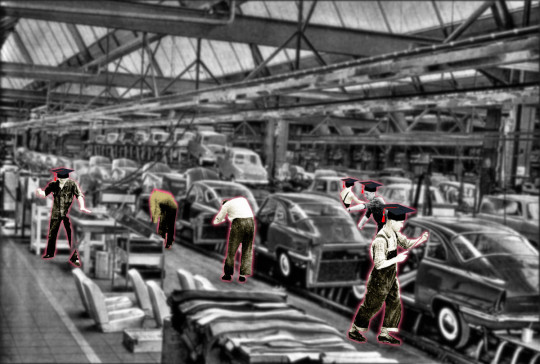
Catch me in Miami! I'll be at Books and Books in Coral Gables on Jan 22 at 8PM.

We moved to America in 2015, in time for my kid to start third grade. Now she's a year away from graduating high school (!) and I've had a front-row seat for the US K-12 system in a district rated as one of the best in the country. There were ups and downs, but high school has been a monster.
We're a decade and a half into the "common core" experiment in educational standardization. The majority of the country has now signed up to a standardized and rigid curriculum that treats overworked teachers as untrustworthy slackers who need to be disciplined by measuring their output through standard lessons and evaluations:
https://en.wikipedia.org/wiki/Common_Core
This system is rigid enough, but it gets even worse at the secondary level, especially when combined with the Advanced Placement (AP) courses, which adds another layer of inflexible benchmarks to the highest-stakes, most anxiety-provoking classes in the system:
https://en.wikipedia.org/wiki/Advanced_Placement
It is a system singularly lacking in grace. Ironically, this unforgiving system was sold as a way of correcting the injustice at the heart of the US public education system, which funds schools based on local taxation. That means that rich neighborhoods have better funded schools. Rather than equalizing public educational funding, the standardizers promised to ensure the quality of instruction at the worst-funded schools by measuring the educational outcomes with standard tools.
But the joke's on the middle-class families who backed standardized instruction over standardized funding. Their own kids need slack as much as anyone's, and a system that promises to put the nation's kids through the same benchmarks on the same timetable is bad for everyone:
https://pluralistic.net/2021/11/28/give-me-slack-2/
Undoing this is above my pay-grade. I've already got more causes to crusade on than I have time for. But there is a piece of tantalyzingly low-hanging fruit that is dangling right there, and even though I'm not gonna pick it, I can't get it out of my head, so I figured I'd write about it and hope I can lazyweb it into existence.
The thing is, there's a reason that standardization takes hold in so many domains. Agreeing on a common standard enables collaboration by many entities without any need for explicit agreements or coordination. The existence of the ANSI/SAE J563 standard automobile auxiliary power outlet (AKA "car cigarette lighter") didn't just allow many manufacturers to make replacement lighter plugs. The existence of a standardized receptacle delivering standardized voltage to standardized contacts let all kinds of gadgets be designed to fit in that socket.
Standards crystallize the space of all possible ways of solving a problem into a range of solutions. This inevitably has a downside, because the standardized range might not be optimal for all applications. Think of the EU's requirement for USB-C charger tips on all devices. There's a lot of reasons that manufacturers prefer different charger tips for different gadgets. Some of those reasons are bad (gouging you on replacement chargers), but some are good (unique form-factor, specific smart-charging needs). USB-C is a very flexible standard (indeed, it's so flexible that some people complain that it's not a standard at all!) but there are some applications where the optimal solution is outside its parameters.
And still, I think that the standardization on USB-C is a force for good. I have drawers full of gadgets that need proprietary charger tips, and other drawers full of chargers with proprietary tips, and damned if I can make half of them match up. We've continued our pandemic lockdown tradition of my wife cutting my hair in the back yard, and just tracking the three different charger tips for the three clippers she uses is an ongoing source of frustration. I'd happily trade slightly sub-optimal charging for just being able to plug any of those clippers into the same cable I charge my headphones, phone, tablet and laptop on.
The standardization of American education has produced all the downsides of standardization – a rigid, often suboptimal, one-size-fits-all system – without the benefits. With teachers across America teaching in lockstep, often from the same set texts (especially in the AP courses), there's a massive opportunity for a commons to go with the common core.
For example, the AP English and History classes my kid takes use standard texts that are often centuries old and hard to puzzle out. I watched my kid struggle with texts for learning about "persuasive rhetoric" like 17th century pamphlets that inspired anti-indigenous pogroms with fictional accounts of "Indian atrocities."
It's good for American schoolkids to learn about the use of these blood libels to excuse genocide, but these pamphlets are a slog. Even with glossaries in the textbooks, it's a slow, word-by-word matter to parse these out. I can't imagine anyone learning a single thing about how speech persuades people just by reading that text.
But there's nothing in the standardized curriculum that prevents teachers from adding more texts to the unit. We live in an unfortunate golden age for persuasive texts that inspire terrible deeds – for example, kids could also read core Pizzagate texts and connect the guy who shot up the pizza parlor to the racists who formed a 17th century lynchmob.
But teachers are incredibly time-constrained. For one thing, at least a third of the AP classroom time seems to be taken up with detailed instructions for writing stilted, stylized "essays" for the AP tests (these are terrible writing, but they're easy to grade in a standardized way).
That's where standardization could actually deliver some benefits. If just one teacher could produce some supplemental materials and accompanying curriculum, the existence of standards means that every other teacher could use it. What's more, any adaptations that teachers make to that unit to make them suited to their kids would also work for the other teachers in the USA. And because the instruction is so rigidly standardized, all of these materials could be keyed to metadata that precisely identified the units they belonged to.
The closest thing we have to this are "marketplaces" where teachers can sell each other their supplementary materials. As far as I can tell, the only people making real money from these marketplaces are the grifters who built them and convinced teachers to paywall the instructional materials that could otherwise form a commons.
Like I said, I've got a completely overfull plate, but if I found myself at loose ends, trying to find a project to devote the rest of my life to, I'd be pitching funders on building a national, open access portal to build an educational commons.
It may be a lot to expect teachers to master the intricacies of peer-based co-production tools like Git, but there's already a system like this that K-8 teachers across the country have mastered: Scratch. Scratch is a graphic programming environment for kids, and starting with 2019's Scratch 3.0, the primary way to access it is via an in-browser version that's hosted at scratch.mit.edu.
Scratch's online version is basically a kid- (and teacher-)friendly version of Github. Find a project you like, make a copy in your own workspace, and then mod it to suit your own needs. The system keeps track of the lineage of different projects and makes it easy for Scratch users to find, adapt, and share their own projects. The wild popularity of this system tells us that this model for a managed digital commons for an educational audience is eminently achievable.
So when students are being asked to study the rhythm of text by counting the numbers of words in the sentences of important speeches, they could supplement that very boring exercise by listening to and analyzing contemporary election speeches, or rap lyrics, or viral influencer videos. Different teachers could fork these units to swap in locally appropriate comparitors – and so could students!
Students could be given extra credit for identifying additional materials that slot into existing curricular projects – Tiktok videos, new chart-topping songs, passages from hot YA novels. These, too, could go into the commons.
This would enlist students in developing and thinking critically about their curriculum, whereas today, these activities are often off-limits to students. For example, my kid's math teachers don't hand back their quizzes after they're graded. The teachers only have one set of quizzes per unit, and letting the kids hold onto them would leak an answer-key for the next batch of test-takers.
I can't imagine learning math this way. "You got three questions wrong but I won't let you see them" is no way to help a student focus on the right areas to improve their understanding.
But there's no reason that math teachers in a commons built around the (unfortunately) rigid procession of concepts and testing couldn't generate procedural quizzes, specified with a simple programming language. These tests could even be automatically graded, and produce classroom stats on which concepts the whole class is struggling with. Each quiz would be different, but cover the same ground.
When I help my kid with her homework, we often find disorganized and scattered elements of this system – a teacher might post extensive notes on teaching a specific unit. A publisher might produce a classroom guide that connects a book to specific parts of the common core. But these are scattered across the web, and they aren't keyed to the specific, standard components of common core and AP.
This is a standardized system that is all costs, no benefits. It has no "architecture of participation" that lets teachers, students, parents, practitioners and even commercial publishers collaborate to produce a commons that all may share and improve upon.
In an ideal world, we'd get rid of standardization in education, pay teachers well, give them the additional time they needed to prepare exciting and relevant curriculum, and fund all our schools based on need, not parents' income.
But in the meanwhile, we could be making lemonade of out lemons. If we're going to have standardization, we should at least have the collaboration standards enable.
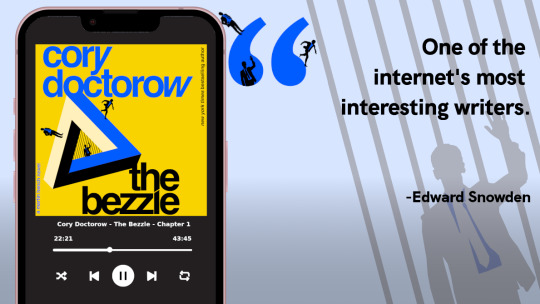
I'm Kickstarting the audiobook for The Bezzle, the sequel to Red Team Blues, narrated by @wilwheaton! You can pre-order the audiobook and ebook, DRM free, as well as the hardcover, signed or unsigned. There's also bundles with Red Team Blues in ebook, audio or paperback.

If you'd like an essay-formatted version of this post to read or share, here's a link to it on pluralistic.net, my surveillance-free, ad-free, tracker-free blog:
https://pluralistic.net/2024/01/16/flexibility-in-the-margins/#a-commons
499 notes
·
View notes
Text

🎃What’s the best way to kick off October? With pumpkins, of course! Did you know that pumpkins are fruits? The flowering plants that bear pumpkins are native to the Americas and are part of the family that includes watermelon, cucumbers, and zucchini. As angiosperms, pumpkin plants rely heavily on insects like bees to help transfer pollen from male flowers to female flowers. Pumpkins come in all sizes: In 2021, a farmer in Tuscany, Italy, showcased a 2,702-lb- (1,226-kg-) pumpkin—the heaviest one to date—at Italy's Lo Zuccone (the pumpkin) championship!
Photo: Linnaea Mallette, CC0, Public Domain Pictures
#pumpkin#fall#autumn#october#did you know#fact of the day#botany#natural history#natural science#cool facts#fruits
437 notes
·
View notes
Note
I'm doing a College class on Ancient Foods. My focus is on Honey like the different recipes and usages in Medieval era. I found like a couple recipes, a thing on religious relation ("Milk and Honey of Paradise") /Crusades, medicinal use, and possibly bees/beeswax because I was struggling to get something.
Y'all have any recommendations?
(I've brought Zoe in on this one; the following is a collaborative effort. Also I'm assuming you have access to your university library so you can get ahold of the cited material below quickly and for free.)
Can you include beverages? Honey is the main ingredient in mead, which should give you a lot to talk about. Susan Verberg is the premier researcher on medieval mead, and has some excellent works on both mead making and honey production. She has a website at https://medievalmeadandbeer.wordpress.com/ where you can find both her formal publications and her blog.
If you do want to talk about beverages, there were other medieval drinks that used honey. Some citations for you:
Breeze, Andrew. “What Was ‘Welsh Ale' in Anglo-Saxon England?” Neophilologus, vol. 88, no. 2, 2004, pp. 299–301.
Fell, Christine E. “Old English ‘Beor’." Leeds Studies in English, vol. 8, 1975, pp. 76-95.
You can also go into cultural symbolism; here are a couple on that:
Enright, Michael J. Lady with a Mead Cup: Ritual, Prophecy, and Lordship in the European Warband from La Tène to the Viking Age. Four Courts Press, 2013.
Rowland, Jenny. “OE Ealuscerwen/Meoduscerwen and the Concept of ‘Paying for Mead'." Leeds Studies in English, vol. 21, 1990, pp. 1-12.
Also you might want to look into the general concept of the "mead of poetry" from the Old Norse sources. You can find the origin story for that in the Prose Edda, I believe.
Definitely check out https://www.foodtimeline.org for recipes with honey during the period - they have more than you'd expect. There's also a few medieval cookbooks you can parse through. Here's an online one you can sort through that does a great job modernizing the translations: https://www.medievalcookery.com/etexts.html
As for honey itself -- there's actually quite a bit of research on that! Honey was quite a specialized trade, and most of the medieval world used it for sweetener, so there's a good amount of research.
A few leads:
honey as an alternative to sugar, which was expensive, imported, and could indicate class
honey grading: honey was graded based on location/provenance, type (lavender, orange blossom, etc.), and also by grade. However, their method of grading was very different to our modern one.
honey as a preservative, not just for flavor
Articles on this subject:
(DEFINITELY this one!!) Fava, Lluis Sales, et al. “Beekeeping in Late Medieval Europe: A Survey of Its Ecological Settings and Social Impacts.” Anales de La Universidad de Alicante. Historia Medieval, no. 22, 2021, pp. 275-96, https://doi.org/10.14198/medieval.19671.
Wallace-Hare, David, editor. New Approaches to the Archaeology of Beekeeping. Archaeopress, 2022. JSTOR, https://doi.org/10.2307/j.ctv2b07txd.
Verberg, Susan. “Of Hony: A Collection of Mediaeval Brewing Recipes for Mead, Metheglin, Braggot, Hippocras &c. — Including how to Process Honey — from the 1600s and Earlier,” 2017. Academia.edu.
If you want to look more into the medicinal usage, Cockayne's Leechdoms, Wortcunning, & Starcraft collects all the medical & scientific texts of the Old English period. It's old enough to be public domain, so it's available on the Internet Archive and HathiTrust in searchable form, meaning you can just ctrl-F "honey" and see what comes up.
Let us know how it goes!
55 notes
·
View notes
Text
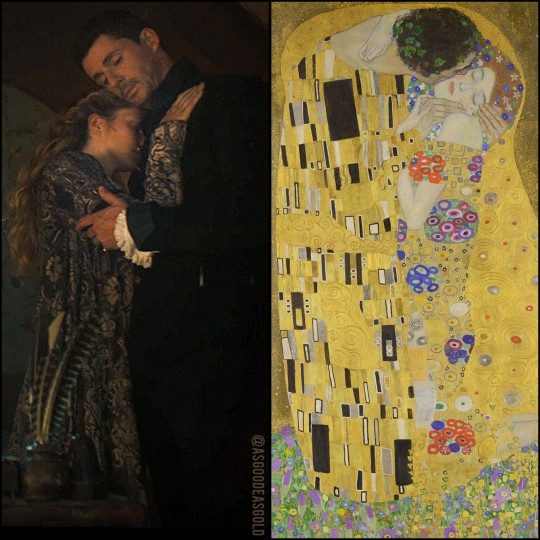
This scene always made me think of Klimt's The Kiss
📷 📷 Sky/Bad Wolf A Discovery of Witches (2021) s2 my edit and Klimt pic from Wikipedia (public domain).
#matthew goode#matthewgoode#teresa palmer#a discovery of witches#adow#gustav klimt#klimt#the kiss#lovers
101 notes
·
View notes
Text
Apparently transpeople will also die from the inaccurate recording of Sex within statistics
The collection of data on a person’s sex – that is, whether they are male or female – has become controversial in recent years, and a number of public bodies have moved away from collecting data on sex as a result. For example, Scotland’s chief statistician recently issued guidance stating that data on sex should only be collected in exceptional circumstances. This move has been greeted with alarm by quantitative social scientists who believe that data on sex is vitally important and that data on both gender identity and sex is needed.
The Office for National Statistics (ONS) was also embroiled in controversy when it proposed to guide respondents to the 2021 England and Wales census that they may answer the sex question in terms of their subjective gender identity, rather than their sex. This was despite the fact that the 2021 census also included a new separate question on gender identity. The ONS was forced to change its proposed guidance on the sex question by a judicial review and went on to advise that people should answer the first question to reflect their legal sex. The Scottish census authorities have been criticised for disregarding the implications of that judgment.
Statistics on employment, health, crime and education have all been affected by this trend.
The Government Equalities Office has issued guidance to employers who are legally bound to report on their gender pay gap to provide data on their employees’ gender identity, not their sex, and to exclude employees who “do not identify as ‘men’ or ‘women’” from the data. This makes it impossible to assess whether natal males who identify as trans or non-binary may have different labour-market experiences from natal females who identify as trans or non-binary. Yet non-binary or transgender identification may not protect females from discrimination, for example, on the basis of pregnancy or maternity or the perceived risk of becoming pregnant.
The NHS decides who to call for routine medical screenings based on the gender marker a person has recorded with their GP rather than their sex as recorded as birth. The NHS’s failure to record biological sex on patient records has led to trans patients not being called in for screening for conditions that may affect them due to their sex, such as ovarian cancer or prostate cancer. If trans patients are not screened for such conditions, the consequences are potentially fatal. The use of gender identity rather than sex has also led to confusion for some trans patients attempting to use sexual health services.
Freedom of information requests have revealed that multiple police forces in England now record crimes by male suspects as committed by women if the perpetrator requests to be recorded as such. Even small numbers of cases misclassified in this way can lead to substantial bias in crime statistics.
Differences between the sexes are an important factor for analysis in most, if not all, of the areas that social and health scientists address. Sex, alongside age, is a fundamental demographic variable, vital for projections regarding fertility and life expectancy. Sex has systematic effects on physical health and is also linked to mental health. And the importance of sex extends to all aspects of social life, including employment, education and crime.
We know that many differences between the sexes have changed dramatically over time – education and labour market participation are two examples. Without consistent data on sex, social scientists would not be able to track this change over time or to understand whether efforts to improve the representation of women and girls in domains where they are underrepresented have been effective.
We have been losing data on sex, as public sector bodies have switched to collecting data on gender identity instead. But the tide may have turned. The UK Statistics Authority has recently published guidance that recommends that “sex, age and ethnic group should be routinely collected and reported in all administrative data and in-service process data, including statistics collected within health and care settings and by police, courts and prisons”. It also says data producers should clearly distinguish between concepts such as sex, gender and gender identity.
Both people’s material circumstances and their identities are important to their lives. We know that sex matters, and we have much to learn about the ways in which gender identity matters, too. Rather than removing data on sex, we should collect data on both sex and gender identity, in order to develop a better understanding of the influence of both of these factors and the intersection between them.
Original article in The Conversation
Professor Alice Sullivan’s academic profile
UCL Social Research Institute
137 notes
·
View notes
Photo

«Antoni Jażwiński’s Tableau Muet, based on the original "Polish System" for charting historical information, later revised in France and the United States, 1834» [source: David Rumsey Historical Map Collection]. In Hunter Dukes and Adam Green, Visualizing History: The Polish System, «The Public Domain Review», May 5, 2021
#education#history#infographic#visual design#visual writing#diagram#geometry#pattern#structure#journal#antoni jażwiński#hunter dukes#adam green#david rumsey map center#the public domain review#1830s#2020s
104 notes
·
View notes
Text
I don't really understand people who get super worked up about who DC currently deems to be the future Batman, Superman or Wonder Woman.
In 2011 Dick still talked about Tim Drake as if he would be Batman one day:
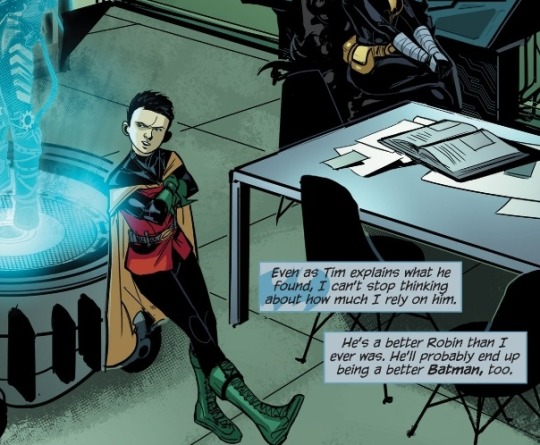
In 2021 DC tried to sell Jace Fox as the future Batman.
And currently some stories seem to try to push the idea that Damian will become Batman one day.
But I bet in 20 years Batman is still going to be Bruce Wayne, as he has been for pretty much the entirety of the last 80 years, because even when the character enters the public domain in ten years there will still be so many parts of Batman's world that they will still have the rights to that I doubt DC or Warner Brothers will seriously try to replace the iconic characters for good.
The future never arrives in DC, it's stuck in an eternal present day.
#For all we know Damian Jon and now Wonder Woman's daughter might not even be around in 20 years#DC just needs to decide the trinity should be young free and childless after the next reboot and these characters are all gone#They have erased sooo many kids over the years#Who says they won't do it again
86 notes
·
View notes
Text
Glass Onion (2022): Mixed company, mixed feelings
This movie is very Current Year, even though it finished shooting in 2021 and is set in May 2020. One minor joke early on; Blanc plays Among Us during lockdown, because he's so bored.
I am not making that up.

I had the same issue with the first movie. I wasn't sure what all the Topical References™ added to the movie. And I know we love to say that great art is timeless.
But as someone who actually does read a lot of old, public-domain, popular books, many had topical social issues in them. Heck, the first Doc Thorndyke book is about fingerprinting, which was cutting edge science at the time, and even makes a self-depreciating joke about it's inspiration, Sherlock Holmes.
I've enjoyed the odd Clancy or Connelly or Cussler or Cavanaugh or Patterson thriller. And those tend to be pretty topical. (obnoxiously so, in one case) Not to mention my love of the Vorkosigan Saga, which was so progressive in the 80s it's still progressive now.
I've also seen stories that had poorly integrated topical issues and much better-handled ones in the same show. The same episode, even.
So I don't know why the political stuff in the two movies rankled. I'd say my issue is "politics I disgree with", but I just mentioned enjoying a book series which is clearly waaay to my left.
Heck, both movies are blatantly inspired by Agatha Christie, and I distinctly recall topical stuff in my mum's old copy of *Third Girl*.
Like, literally the whole plot.
I read it a long time ago, but I think I'd still enjoy it.
Other, less important criticism. And spoilers.
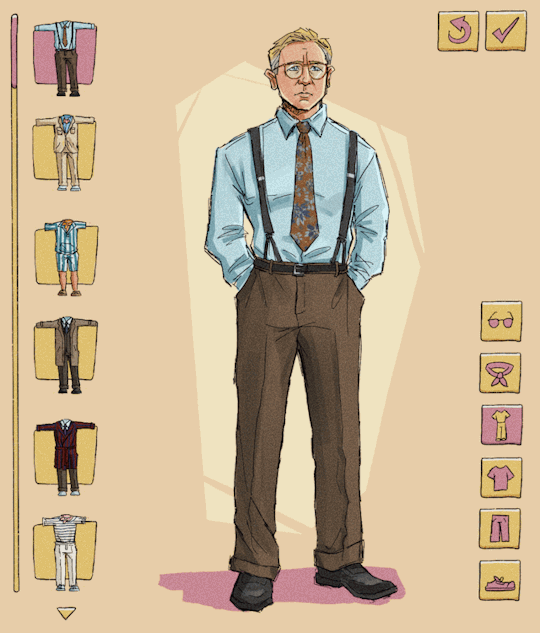
-Blanc intially felt like a caricature, which was very different from the way he appeared in the first movie. turns out that's deliberate. He later says he was playing up the folksy Southernness.
Even though he's an internationally famous detective who lives in a $10,000,000 Park Avenue penthouse.
Don't ask me about the high-waisted pants, the cute little scarf around his neck, or the 19th century bathing costume he wears to the pool. Apparently his style in this movie was partially Daniel Craig's idea.
Also, he's gay.
It's not made explicitly clear during the film, and the guy he's living with could be a roomie or friend or assistant, but Johnson confirmed it. I'm not sure what it adds to the film, except an explanation for the scarf.
And also some irony when Birdie flirts with him, even though he's famous and probably publicly known to be gay. Heck, just his visible discomfort in those scenes would be irony enough, whether or not he liked women.
Miles Bronn
-possible shallow Elon musk parody
--he’s fooling people w/ fake genius, when he's really just a charismatic idiot. And one who gets swindled, possibly.
-There's one bit of irony. Early on, Miles guests on his private island get a COVID vaccine. It later turns out Miles is an idiot.
Since the movie takes place entirely in May 2020, the implication is that Miles should know it's basically impossible to develop a proper vaccine in just a few short months.
Cough.

The actual main protagonist isn't Blanc, it's Cassandra "Andi" Brand and Helen Brand. Andi is a tech genius who Miles ripped off. And also murdered. So her twin sister Helen, a teacher, steps in.
Anyone familiar with the Trojan War is probably going "hey, wait a minute..." Did I mention that this takes place on a Greek island in the Aegean Sea? Which has Troy on its borders?
And the first things we see in the film are tantalizing wooden boxes?
Helen poses as Andi with Blanc's help, so they can investigate the murder and figure out which of Miles friends, “the Disruptors”, killed Andi.
Both Brands are played by Janelle Monae. A famously left-wing singer and actress, whose biggest film role was in the movie Hidden Figures, where she played one of a team of black women in STEM forgotten by history.
And in this movie, Monae plays two hidden figures, eclipsed by white men. One maliciously, one charitably.
Birdie
--Birdie is an idiotic middle-aged singer who keeps getting cancelled because she does dumb stuff.
-She sexually harasses Blanc. This is possibly why Blanc's gay, to make it extra ironic.
-She's introduced at a party during lockdowns. When she arrives at the island, she wears a completely decorative facemask.
-Birdie prides herself on her honesty. In this case, it means she's inconsiderate and narcissistic, with no filter. Which makes it kinda ironic (or something?) when the day is saved in the end by a combination of lies and truth.
Duke
-Dave Bautista plays an alt-right mra. Supposedly.
-He supports a girlfriend and his mother, who abuses him. He's three or four times mom's size. He goes "Mom, I told you not to interrupt when I'm recording!" and she physically slaps him. Not even any ramp-up, she just does it.
She also tries to disrupt his call with his friends by "helping" him solve Miles' puzzle box, right up until it's done, and she stops caring.
So the show decided to mock MRAs by...making one a male victim of domestic violence and emotional abuse from a woman.

And from what I saw on Youtube, plenty of people didn't notice the irony. In fact, I found an official Netflix short of the scene, and the comments were glad he was getting "put in his place" because he politely asked him mom to let him do his job.
Also, remember when I mentioned how Birdie sexually harasses Blanc?
This movie includes two examples of the exact sort of issues MRAs talk about all the time.
-I know he's supposed to be a parody, but of who, exactly? jordan peterson? andrew tate? Pewdiepie? All of the above?

I think they even got some alex jones in there when they mention how he sold pills. Specifically, "performance" pills for men, made from rhino horn.
-Duke carries a gun near his crotch at all times for most of the movie. Specifically, an underpowered Tokarev, I've read. On top of the abuse, he also self-cucks himself so his GF can try and pillow-talk Miles into supporting Duke's next endeavour.
Subtle.
And while I was looking up the gun, I found someone on /r/liberalGunOwners saying "well, maybe it's supposed to look Russian because he's pro-Putin like a lot of right-wingers?"

That's possible, but it would be a really obtuse reference in a movie chock full of really blatant references.
-Also, there's something a tad ironic about a supposedly (alt-)right influencer being a large, muscular, tattoo'd Hispanic man. Unless that's supposed to be a tan.
Claire
-Claire is a left-wing, environmentally friendly politician. She wears beige, and always looks terrible (to Katheryn Hahn's frustration). She's also a hypocrite.
Some TVTropes editor: it's about progressive politicans that gradually turn conservative.
No, the message here isn't "conservatives bad". It's "hypocritical left-wing politicians are bad". And I'm not sure about the "left-wing" part.
Duke is a hypocrite because he self-cucks for advantage, and is also physically abused by his tiny little mom. Claire is just a straight up liar, as politicians often are. There's a contrast between his performative peacocking in every aspect of the way he presents himself, and Claire's beige cold mess.
I'm not kidding. That was the stated intent of her costume and makeup.
-claire calls duke an MRA. I'm not sure if the writers were wrong, Claire's wrong, or Duke actually calls himself an MRA in-universe. He's certainly a traditionalist, which MRAs usually aren't. He also wants women to get back in the kitchen, which MRAs usually don't.
And finally, there's Miles’ No 2., tech wizard Lionel, who spins Miles' straw - or napkin ideas - into gold. In fact, he spends most of the movie with a gold wishbone pin on his lapel. GEDDIT?
Duke is a right wing tradcon MRA who cares about physical appearances even though he has a bad social rep, Claire is a left-wing progressive with a terrible physical appearance and a good social rep, Birdie is an idiot who keeps saying un-PC things, and Lionel is the smart guy, who is apparently more or less apolitical.
Also, the movie has obvious inspiration from Christie's "And Then There Were None". And maybe Clue. Or Among Us.
Or all three.
48 notes
·
View notes
Text
So back in 2021 I released a little game called Wild Duelist. It's a medieval action game, Illuminated by LUMEN, about honour and violence. It concerns animalfolk warriors travelling to arranged duels along dangerous paths.
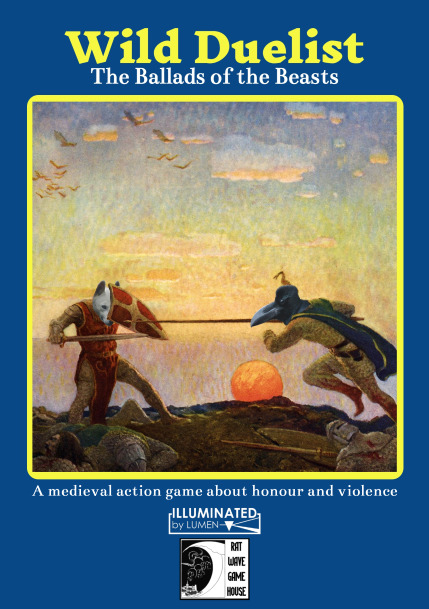
I'm working on two supplements for the game at the moment. The first , The Ballad of the Bastard and the Tinkerer, is a quickstart adventure for three players. The second, Bloody Hands Dig Shallow Graves, is a longer campaign-length adventure.
I started working in some art for the quickstart today.
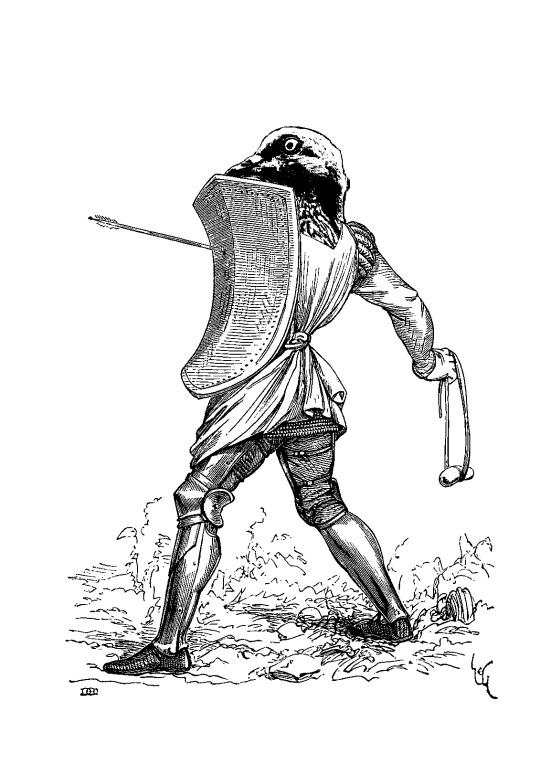


(the style is a digital collage of medieval public domain illustrations with animal photos)
#game design#indie ttrpg#ttrpg#i described the game before as Disneys Robin Hood meets A24s the Green Knight#arthurian
98 notes
·
View notes
Text
2023's public domain is a banger

40 years ago, giant entertainment companies embarked on a slow-moving act of arson. The fuel for this arson was copyright term extension (making copyrights last longer), including retrospective copyright term extensions that took works out of the public domain and put them back into copyright for decades. Vast swathes of culture became off-limits, pseudo-property with absentee landlords, with much of it crumbling into dust.
After 55-75 years, only 2% of works have any commercial value. After 75 years, it declines further. No wonder that so much of our cultural heritage is now orphan works, with no known proprietor. Extending copyright on all works – not just those whose proprietors sought out extensions – incinerated whole libraries full of works, permanently.
But on January 1, 2019, the bonfire was extinguished. That was the day that items created in 1923 entered the US public domain: DeMille's Ten Commandments, Chaplain's Pilgrim, Burroughs' Tarzan and the Golden Lion, Woolf's Jacob's Room, Coward's London Calling and 1,000+ more works:
https://web.law.duke.edu/cspd/publicdomainday/2019/
Many of those newly liberated works were forgotten, partly due to their great age, but also because no one knew who they belonged to (Congress abolished the requirement to register copyrights in 1976), so no one could revive or reissue them while they were still in the popular imagination, depriving them of new leases on life.
2019 was the starting gun on a new public domain, giving the public new treasures to share and enjoy, and giving the long-dead creators of the Roaring Twenties a new chance at posterity. Each new year since has seen a richer, more full public domain. 2021 was a great year, featuring some DuBois, Dos Pasos, Huxley, Duke Ellington, Fats Waller, Bessie Smith and Sydney Bechet:
https://pluralistic.net/2020/12/16/fraught-superpowers/#public-domain-day
In just 12 days, the public domain will welcome another year's worth of works back into our shared commons. As ever, Jennifer Jenkins of Duke's Center for the Public Domain have painstaking researched highlights from the coming year's entrants:
https://web.law.duke.edu/cspd/publicdomainday/2023/
On the literary front, we have Virginia Woolf's To The Lighthouse, AA Milne's Now We Are Six, Hemingway's Men Without Women, Faulkner's Mosquitoes, Christie's The Big Four, Wharton's Twilight Sleep, Hesse's Steppenwolf (in German), Kafka's Amerika (in German), and Proust's Le Temps retrouvé (in French).
We also get all of Sherlock Holmes, finally wrestling control back from the copyright trolls who control the Arthur Conan Doyle estate. This is a firm of rent-seeking bullies who have abused the court process to extract menaces money from living creators, including rent on works that were unambiguously in the public domain.
The estate's sleaziest trick is claiming that while many Sherlock Holmes stories were in the public domain, certain elements of Holmes's personality were developed in later stories that were still in copyright, and therefore any Sherlock story that contained those elements was a copyright violation. Infamously, the Doyle Estate went after the creators of the Enola Holmes series, claiming a copyright over Sherlock stories in which Holmes was "capable of friendship," "expressed emotion," or "respected women." This is a nonsensical theory, based on the idea that these character traits are copyrightable. They are not:
https://web.law.duke.edu/cspd/publicdomainday/2023/#fn6text
The Doyle Estate's shakedown racket took a serious body-blow in 2013, when Les Klinger – a lawyer, author and prominent Sherlockian – prevailed in court, with the judge ruling that new works based on public domain Sherlock stories were not infringing, even if some Sherlock stories remained in copyright. The estate appealed and lost again, and Klinger was awarded costs. They tried to take the case to the Supreme Court and got laughed out of the building.
But as the Enola Holmes example shows, you can't keep a copyright troll down: the Doyle estate kept making up imaginary copyright laws in a desperate, grasping bid to wring more money out of living, working creators. That's gonna be a lot harder after Jan 1, when The Case-Book of Sherlock Holmes enters the public domain, meaning that every Sherlock story will be out of copyright.
One fun note about Klinger's landmark win over the Doyle estate: he took an amazing victory lap, commissioning an anthology of new unauthorized Holmes stories in 2016 called "Echoes of Sherlock Holmes":
https://www.simonandschuster.com/books/Echoes-of-Sherlock-Holmes/Laurie-R-King/Sherlock-Holmes/9781681775463
I wrote a short story for it, "Sherlock Holmes and the Case of the Extraordinary Rendition," which was based on previously unpublished Snowden leaks.
https://esl-bits.net/ESL.English.Listening.Short.Stories/Rendition/01/default.html
I got access to the full Snowden trove thanks to Laura Poitras, who jointly commissioned the story from me for inclusion in the companion book for "Astro noise : a survival guide for living under total surveillance," her show at the Whitney:
https://www.si.edu/object/siris_sil_1060502
I also reported out the leaks the story was based on in a companion piece:
https://memex.craphound.com/2016/02/02/exclusive-snowden-intelligence-docs-reveal-uk-spooks-malware-checklist/
Jan 1, 2023 will also be a fine day for film in the public domain, with Metropolis, The Jazz Singer, and Laurel and Hardy's Battle of the Century entering the commons. Also notable: Wings, winner of the first-ever best picture Academy Award; The Lodger, Hitchcock's first thriller; and FW "Nosferatu" Mirnau's Sunrise.
However most of the movies that enter the public domain next week will never be seen again. They are "lost pictures," and every known copy of them expired before their copyrights did. 1927 saw the first synchronized dialog film (The Jazz Singer). As talkies took over the big screen, studios all but gave up on preserving silent films, which were printed on delicate stock that needed careful tending. Today, 75% of all silent films are lost to history.
But some films from this era do survive, and they are now in the public domain. This is true irrespective of whether they were restored at a later date. Restoration does not create a new copyright. "The Supreme Court has made clear that 'the sine qua non of copyright is originality.'"
https://www.law.cornell.edu/supremecourt/text/499/340
There's some great music entering the public domain next year! "The Best Things In Life Are Free"; "I Scream, You Scream, We All Scream for Ice-Cream"; "Puttin' On the Ritz"; "'S Wonderful"; "Ol' Man River"; "My Blue Heaven" and "Mississippi Mud."
It's a banger of a year for jazz and blues, too. We get Bessie Smith's "Back Water Blues," "Preaching the Blues," and "Foolish Man Blues." We get Louis Armstrong's "Potato Head Blues" and "Gully Low Blues." We get Jelly Roll Morton's "Billy Goat Stomp," "Hyena Stomp," and "Jungle Blues." And we get Duke Ellington's "Black and Tan Fantasy" and "East St. Louis Toodle-O."
Note that these are just the compositions. No new sound recordings come into the public domain in 2023, but on January 1, 2024, all of 1923's recordings will enter the public domain, with more recordings coming in every year thereafter.
We're only a few years into the newly reopened public domain, but it's already bearing fruit. The Great Gatsby entered the public domain in 2021, triggering a rush of beautiful new editions and fresh scholarship:
https://www.nytimes.com/2021/01/14/books/the-great-gatsby-public-domain.html
These new editions were varied and wonderful. Beehive Books produced a stunning edition, illustrated by the Balbusso Twins, with a new introduction by Wellesley's Prof William Cain:
https://beehivebooks.com/shop/gatsby
And Planet Money released a fabulous, free audiobook edition:
https://pluralistic.net/2021/01/18/peak-indifference/#gatsby
Last year saw the liberation of Winnie the Pooh, unleashing a wild and wonderful array of remixes, including a horror film ("Blood and Honey") and also innumerable, lovely illustrations and poems, created by living, working creators for contemporary audiences.
As Jenkins notes, many of the works that enter the public domain next week display and promote "racial slurs and demeaning stereotypes." The fact that these works are now in the public domain means that creators can "grapple with and reimagine them, including in a corrective way." They can do this without having to go to the Supreme Court, unlike the Alice Randall, whose "Wind Done Gone" retold "Gone With the Wind" from the enslaved characters' perspective:
https://en.wikipedia.org/wiki/The_Wind_Done_Gone
After all this, you'd think that countries around the world would have learned their lesson on copyright term extension, but you'd be wrong. In Canada, Justin Trudeau caved to Donald Trump and retroactively expanded copyright terms by 20 years, as part of USMCA, the successor to NAFTA. Trudeau ignored teachers, professors, librarians and the Minister of Justice, who said that copyright extension should require "a modest registration requirement" – so 20 years of copyright will be tacked onto all works, including those with no owners:
https://www.michaelgeist.ca/2022/04/the-canadian-government-makes-its-choice-implementation-of-copyright-term-extension-without-mitigating-against-the-harms/
Other countries followed Canada's disastrous lead: New Zealand "agreed to extend its copyright term as a concession in trade agreements, even though this would cost around $55m [NZ dollars] annually without any compelling evidence that it would provide a public benefit":
https://www.newsroom.co.nz/nz-agrees-to-mickey-mouse-copyright-law
Wrapping up her annual post, Jenkins writes of a "melancholy" that "comes from the unnecessary losses that our current system causes—the vast majority of works that no longer retain commercial value and are not otherwise available, yet we lock them all up to provide exclusivity to a tiny minority.
"Those works which, remember, constitute part of our collective culture, are simply off limits for use without fear of legal liability. Since most of them are 'orphan works' (where the copyright owner cannot be found) we could not get permission from a rights holder even if we wanted to. And many of those works do not survive that long cultural winter."
[Image ID: A montage of works that enter the public domain on Jan 1, 2023.]
#pluralistic#copyright#usmca#james boyle#jennifer jenkins#canpoli#canada#silent films#enola holmes#les klinger#copyright trolls#rogers and hammerstein#irving berlin#laurel and hardy#marcel proust#ernest hemingway#william faulkner#copyfight#public domain#remix#preservation#al jolson#winnie the pooh#franz kafka#virginia woolf#metropolis#sherlock holmes
632 notes
·
View notes
Text
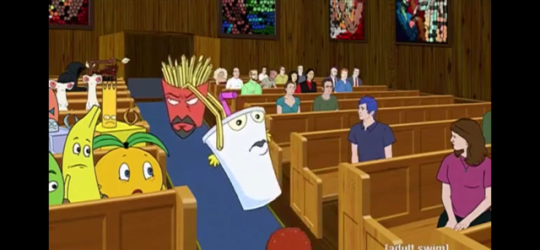
Aqua Teen Hunger Force #93: “A PE Christmas” | December 13, 2009 - 11:45PM | S08E01
regular series version aired March 15, 2010 @ 12:00AM
It’s the Aqua Teen Christmas episode, in which Shake and Meatwad steal Public Enemy’s identity and try to cut a rap record to sell on Christmas. It’s a pretty bad plan because they record it on Christmas eve and Shake sorta just believes the CD will appear in stores on Christmas day. The stores aren’t even open on Christmas day!! SHAKE COME ON!
Mostly this one just consists of two scenes: one where the Aqua Teens attend Christmas mass and Shake acts childish. There’s a nice crowd scene filled with people from previous episodes, and for some reason the monsters are all sitting on the opposite side of the room. You hate to see a segregated church on Christmas. Then there’s the scene in the recording studio, with Shake and Meatwad coming up with bad ideas and recording them. The gag at the end of this, where Shake takes a big shit and it winds up on Meatwad’s track for Silent Night, is pretty low-brow, but it’s maybe the funniest thing in the episode. I don’t want to like it, I’m not about that life.
This episode featured a bit of a twist where it turns out that Shake was filled with eels, hence his violent butthole outbursts. The original broadcast of this ended with Shake in jail, because he broke into a Better Buy store to see how his record was selling. He gets exploded to death after a bunch of eels burst out of him. When this episode aired as part of season seven, they added an ending that sorta explains that the Eels belonged to Chuck D (flagrantly misidentified as Flava Flav on the ATHF wiki).
This one’s pretty lame, TBH. There were things in it I liked, but the best thing being a poo poo joke really should sum it all up. It also mildly perturbed me that this one airs between the live-action episode and the official season premiere “Rabbot Redux” which includes some continuity, so I numbered it according to the in-season air order. It also airs in some fucked up order on DVD! I don’t know why! I don’t know why they do that!
Oh yeah I also liked the part where Shake rudely bangs on the glass in the recording studio. Pretty funny.
EPHEMERA CORNER:
youtube
15th Annual Holiday Content Marathon (December 18, 2009)
An evening of Christmas specials. Also scheduled was “Gary’s Posse”, a promo that aired for a show that didn’t actually exist; in fact, I forgot all about this. Gary’s Posse was put on the schedule for AM this evening, but it was just a repeat of King of the Hill. Swimpedia (where I got this and nearly all of my scheduling information from) uncovered the fact that this is actually just stock footage from Julien Tromeur called "Afraid of your sexual fantasies." The promo advertising Gary’s Posse was just a gag.
10:00/2:00 King of the Hill: Livin' on Reds, Vitamin C and Propane
(Schedule Promo Falsely Announced Gary's Posse at 2:00 AM)
10:30/2:30 King of the Hill: 'Twas the Nut Before Christmas
11:00/3:00 Robot Chicken: Dear Consumer
11:15/3:15 The Venture Bros.: A Very Venture Christmas
11:30/3:30 American Dad!: The Best Christmas Story Never
12:00/4:00 Aqua Teen Hunger Force: Cybernetic Ghost of Christmas Past from the Future
12:15/4:15 Aqua Teen Hunger Force: T-Shirt of the Dead
12:30/4:30 Moral Orel: The Best Christmas Ever!
12:45/4:45 Moral Orel: Honor
1:00/5:00 Baby Blues: A Baby Blues Christmas Special
1:30 Tom Goes to the Mayor: Rats Off to Ya!
1:45 Sealab 2021: Feast of Alvis
5:30 Home Movies: The Adventures of Cho & Amy Lee
MAIL BAG
KON writes:
Worth noting about THE VENTURE BROS S04E07 "THE BETTER MAN"... it features the use of the Dana Snyder character completely unironically going "sooo... that happened." Granted this was right before that became the exclusive domain of MCU-type dialogue, but it still hit my ear about as harshly as any Bush-era slur. Nasty!
OH YEAH! I think I made note of that but for some reason it didn't make my write-up. i couldn't tell if that was bad writing or if that was an intentional character thing, but usually characters call each other out for saying stuff like that. So, that happened.
10 notes
·
View notes